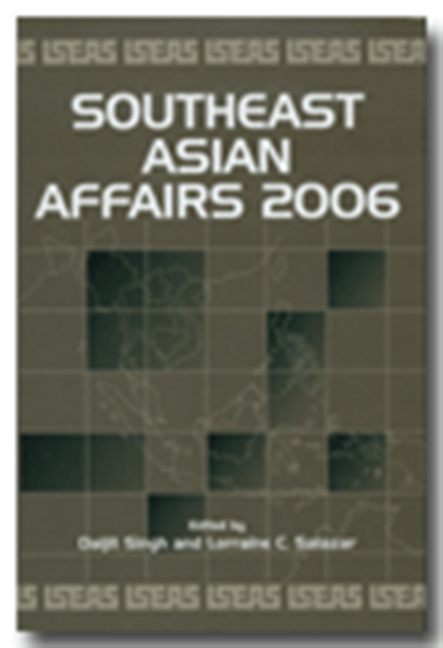Book contents
- Frontmatter
- Contents
- Foreword
- Introduction
- The Region
- Southeast Asia in 2005: Strength in the Face of Adversity
- Southeast Asian Economies: A Year of Exogenous Shocks
- Terrorism: Evolving Regional Alliances and State Failure in Mindanao
- Japan in an Insecure East Asia: Redefining Its Role in East Asian Community-Building
- Brunei darussalam
- Cambodia
- Indonesia
- Laos
- Malaysia
- Myanmar
- The Philippines
- Singapore
- Thailand
- Timor Leste
- Vietnam
Southeast Asia in 2005: Strength in the Face of Adversity
from The Region
Published online by Cambridge University Press: 21 October 2015
- Frontmatter
- Contents
- Foreword
- Introduction
- The Region
- Southeast Asia in 2005: Strength in the Face of Adversity
- Southeast Asian Economies: A Year of Exogenous Shocks
- Terrorism: Evolving Regional Alliances and State Failure in Mindanao
- Japan in an Insecure East Asia: Redefining Its Role in East Asian Community-Building
- Brunei darussalam
- Cambodia
- Indonesia
- Laos
- Malaysia
- Myanmar
- The Philippines
- Singapore
- Thailand
- Timor Leste
- Vietnam
Summary
Southeast Asia greeted 2005 in a sombre mood, as the full scale of devastation in the wake of the tsunami triggered by a massive earthquake that sent giant waves crashing into the coastlines of north Sumatra, southern Thailand, northwestern Malaysia, and Myanmar became apparent. Almost a quarter million people were killed across the region, a loss of life almost too great to comprehend. In Aceh alone as many as 180,000 people died as a wall of dark water 10 metres high travelling at speeds of almost 400 miles an hour rushed onshore crushing everything in its path. From the air, it still looks like the aftermath of an atom blast.
The tsunami was a particular blow for Indonesia, which had just crowned a protracted and messy democratic transition with successful multi-party elections and the first direct presidential election at the end of 2004. The new government led by President Susilo Bambang Yudhoyono was poised to inaugurate a new era of confidence and stability for Indonesia. Hopes ran high. Southeast Asia badly needed its largest component state to get back on track or face the prospect of unfavourable comparison with the booming economies of China and India.
Since 2001, Southeast Asia has been badly buffeted by the global war on terror. A string of bombings in Indonesia and the Philippines, as well as the uncovering of local terrorist cells and networks over the past four years has dragged the region into the terror spotlight. Southeast Asia's most wanted terror suspect, Hambali, was arrested in central Thailand in 2003. Indonesia's resort island of Bali had been the scene of the most devastating and audacious terrorist attack since 2001, when bombs exploded outside nightclubs frequented by Western tourists in Kuta in October 2002 — and another in October 2005. The Philippines is widely suspected to be a haven for Islamic militants who train in remote camps in the southern province of Mindanao. A terrorist attack perpetrated by Islamic extremists was perceived as the principal threat to security in Southeast Asia throughout the year.
- Type
- Chapter
- Information
- Southeast Asian Affairs 2006 , pp. 3 - 14Publisher: ISEAS–Yusof Ishak InstitutePrint publication year: 2006



